Generation of the Quaternary Normal Faults in the Messina Strait (Italy)
Abstract
:1. Introduction
2. Pliocene

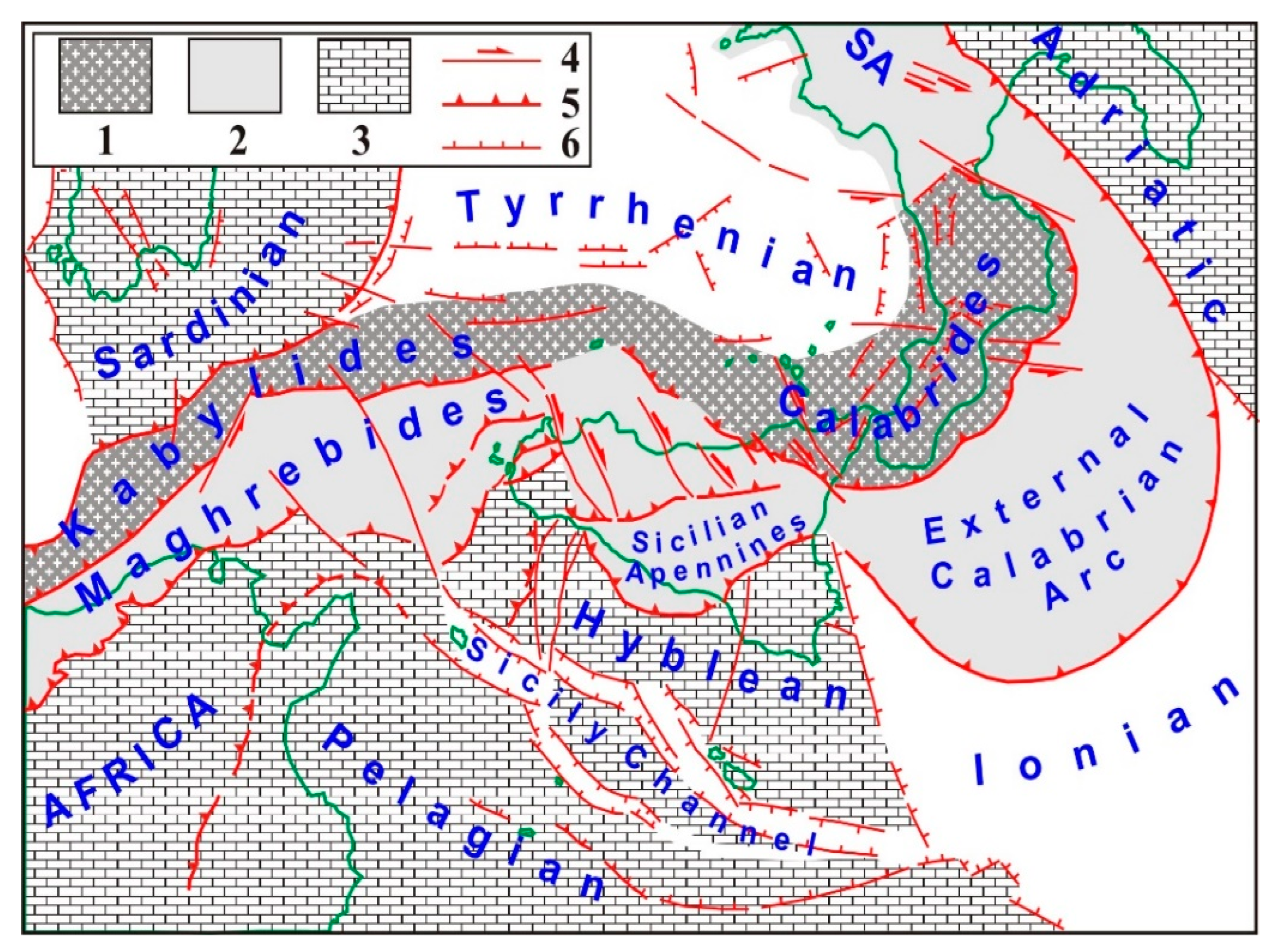
3. Early Pleistocene–Present
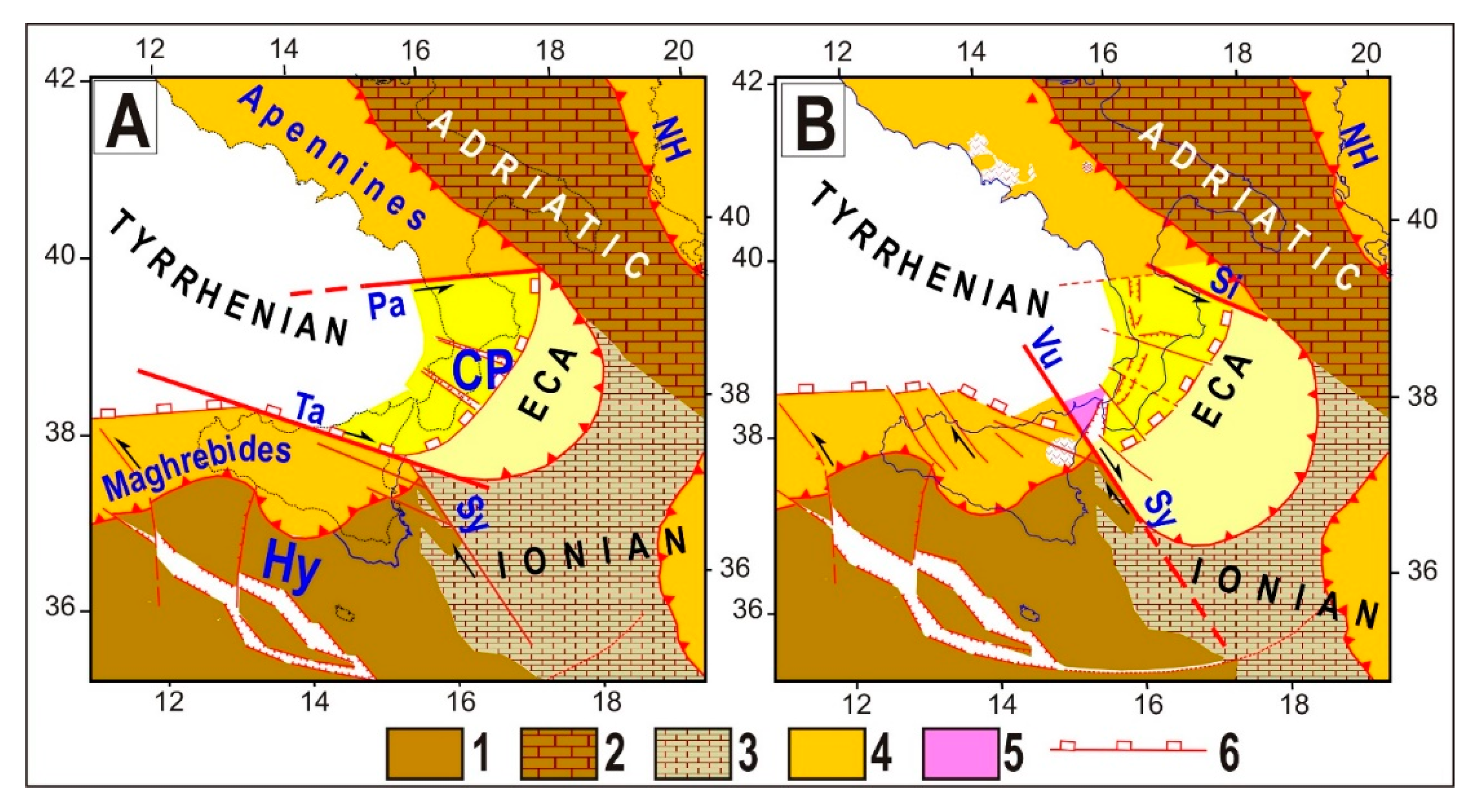
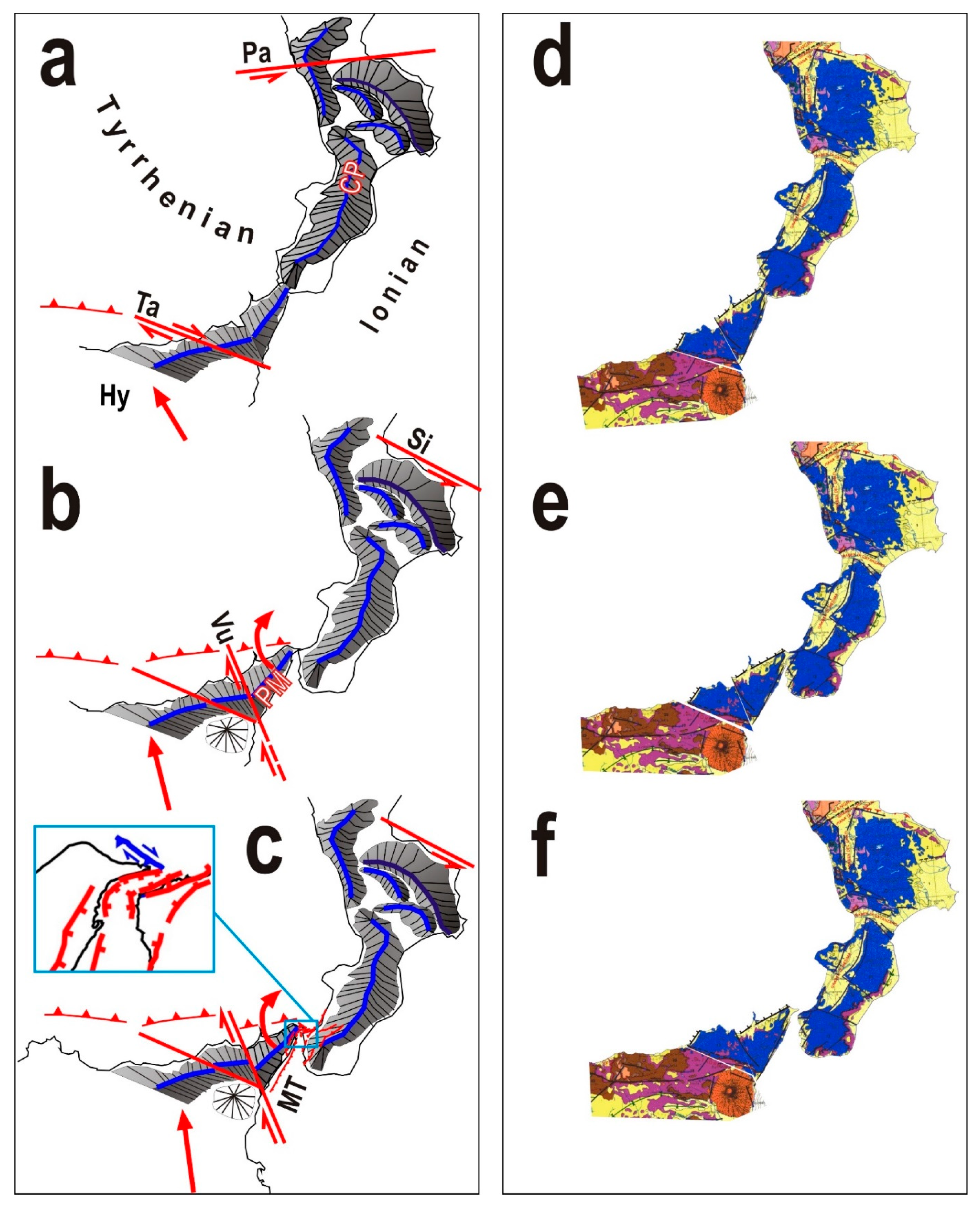
4. Discussion
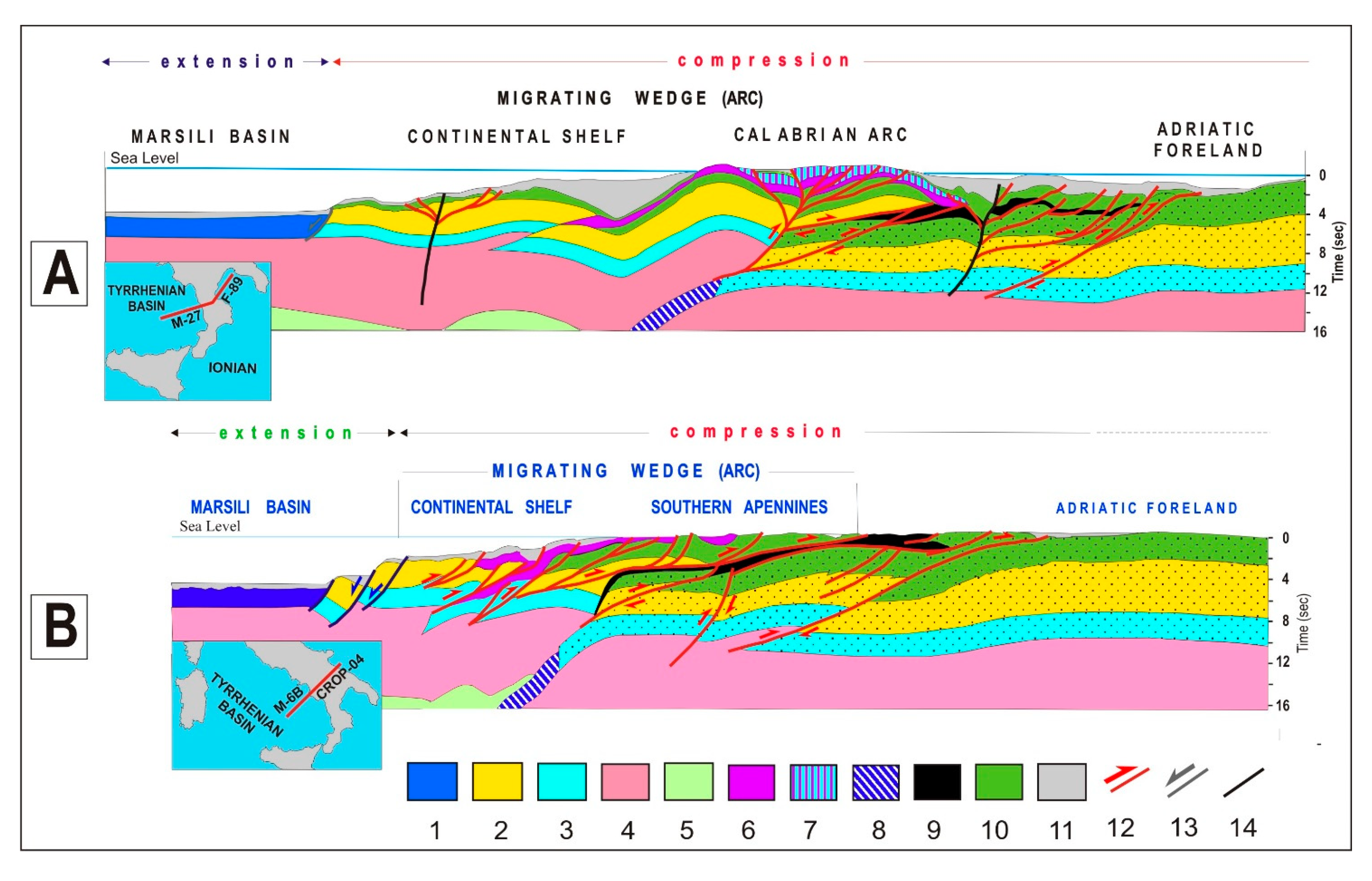
5. Conclusions
Author Contributions
Funding
Data Availability Statement
Acknowledgments
Conflicts of Interest
References
- Peruzza, L.; Pantosti, D.; Slejko, D.; Valensise, G. Testing a new hybrid approach to seismic hazard assessment: An application to the Calabrian Arc (Southern Italy). Nat. Hazards 1997, 14, 113–126. [Google Scholar] [CrossRef]
- Schick, R. Eine Seismotektonische Bearbeitung des Erdbebens von Messina-im Jahre 1908; Geologisches Jahrbuch Reihe E, Band E 11; Schweizerbart Science Publishers: Stuttgart, Germany, 1977; 74p, ISBN 978-3-510-96074–3. [Google Scholar]
- Mulargia, F.; Boschi, E. The 1908 Messina earthquake and related seismicity. In Earthquakes: Observation, Theory and Interpretation, Proceedings of the E. Fermi International School in Physics, Course 85, Varenna; Kanamori, H., Boschi, E., Eds.; Springer: Amsterdam, The Netherlands; New York, NY, USA, 1983; pp. 493–518. [Google Scholar]
- Bottari, A.; Carapezza, E.; Carapezza, M.; Carveni, P.; Cefali, F.; Lo Giudice, E.; Pandolfo, C. The 1908 Messina Strait earthquake in the regional geostructural framework. J. Geodyn. 1986, 5, 275–302. [Google Scholar]
- Capuano, B.Y.P.; Natale, G.D.E.; Gasparini, P.; Pingue, F.; Scarpa, R. A model for the 1908 Messina Straits (Italy) earthquake by inversion of levelling data. Bull. Seismol. Soc. Am. 1988, 78, 1930–1947. [Google Scholar]
- Boschi, E.; Pantosti, D.; Valensise, G. Modello di sorgente per il terremoto di Messina del 1908 ed evoluzione recente dell’area dello Stretto. In Proceedings of the Atti 89th GNDT Workshop, Roma, Italy, 7–9 November 1989; pp. 245–258. [Google Scholar]
- De Natale, G.; Pingue, F. A Variable Slip Fault Model For the 1908 Messina Straits (Italy) Earthquake, By Inversion of Levelling Data. Geophys. J. Int. 1991, 104, 73–84. [Google Scholar] [CrossRef]
- Valensise, G.; Pantosti, D. A 125 Kyr-long geological record of seismic source repeatability: The Messina Straits (Southern Italy) and the 1908 earthquake (Ms 7 1/2). Terra Nova 1992, 4, 472–483. [Google Scholar] [CrossRef]
- Cucci, L.; D’Addezio, G.; Valensise, G.; Burrato, P. Investigating seismogenic faults in Central and Southern Apennines (Italy): Modeling of fault-related landscape features. Ann. Geofis. 1996, 39, 603–618. [Google Scholar]
- Amoruso, A.; Crescentini, L.; Scarpa, R. Source parameters of the 1908 Messina Straits, Italy, earthquake from geodetic and seismic data. J. Geophys. Res. Solid Earth 2002, 107, ESE 4-1–ESE 4-11. [Google Scholar] [CrossRef]
- Aloisi, M.; Bruno, V.; Cannavò, F.; Ferranti, L.; Mattia, M.; Monaco, C.; Palano, M. Are the source models of the M 7.1 1908 Messina Straits earthquake reliable? Insights from a novel inversion and sensitivity analysis of levelling data. Geophys. J. Int. 2013, 192, 1025–1041. [Google Scholar] [CrossRef]
- Convertito, V.; Pino, N.A. Discriminating among distinct source models of the 1908 Messina Straits earthquake by modelling intensity data through full wavefield seismograms. Geophys. J. Int. 2014, 198, 164–173. [Google Scholar] [CrossRef]
- Meschis, M.; Roberts, G.P.; Mildon, Z.K.; Robertson, J.; Michetti, A.M.; Faure Walker, J.P. Slip on a Mapped normal Fault for the 28th December 1908 Messina Earthquake (Mw 7.1) in Italy. Sci. Rep. 2019, 9, 6481. [Google Scholar] [CrossRef]
- Barreca, G.; Gross, F.; Scarfì, L.; Aloisi, M.; Monaco, C.; Krastel, S. The Strait of Messina: Seismotectonics and the Source of the 1908 Earthquake. Earth-Sci. Rev. 2021, 218, 103685. [Google Scholar] [CrossRef]
- Andrenacci, C.; Bello, S.; Barbano, M.S.; de Nardis, R.; Pirrotta, C.; Pietrolungo, F.; Lavecchia, G. Reappraisal and Analysis of Macroseismic Data for Seismotectonic Purposes: The Strong Earthquakes of Southern Calabria, Italy. Geosciences 2023, 13, 212. [Google Scholar] [CrossRef]
- Loperfido, A. Livellazione geometrica di precisione eseguita dall’IGM sulla costa orientale della Sicilia, da Messina a Catania, a Gesso ed a Faro Peloro e sulla costa occidentale della Calabria da Gioia Tauro a Melito di Porto Salvo. In Relazione della Commissione Reale Incaricata di Designare le Zone più Adatte per la Ricostruzione Degli Abitati Colpiti dal Terremoto del 28 Dicembre 1908 o da Altri Precedenti (1909); C.R. Accademia Naz. Lincei: Roma, Italy, 1909; Volume 35, pp. 131–156. [Google Scholar]
- Del Ben, A.; Gargano, C.; Lentini, R. Ricostruzione strutturale e stratigrafica dell’area dello Stretto di Messina mediante analisi comparata dei dati geologici e sismici. Mem. Soc. Geol. It. 1996, 51, 703–717. [Google Scholar]
- Del Ben, A.; Barnaba, C.; Toboga, A. Strike-slip systems as the main tectonic features in the Plio-Quaternary kinematics of the Calabrian Arc. Mar. Geophys. Res. 2008, 29, 1–12. [Google Scholar] [CrossRef]
- Scarfì, L.; Langer, H.; Scaltrito, A. Seismicity, seismotectonics and crustal velocity structure of the Messina Strait (Italy). Phys. Earth Planet. Int. 2009, 177, 65–78. [Google Scholar] [CrossRef]
- Doglioni, C.; Ligi, M.; Scrocca, D.; Bigi, S.; Bortoluzzi, G.; Carminati, E.; Cuffaro, M.; D’Oriano, F.; Forleo, V.; Muccini, F.; et al. The tectonic puzzle of the Messina area (Southern Italy): Insights from new seismic reflection data. Sci. Rep. 2012, 2, 970. [Google Scholar] [CrossRef] [PubMed]
- Malinverno, A.; Ryan, W.B.F. Extension on the Tyrrhenian Sea and shortening in the Apennines as results of arc migration driven by sinking of the lithosphere. Tectonics 1986, 5, 227–245. [Google Scholar] [CrossRef]
- Jolivet, L.; Faccenna, C. Mediterranean extension and the Africa-Eurasia collision. Tectonics 2000, 19, 1095–1106. [Google Scholar] [CrossRef]
- Faccenna, C.; Funiciello, F.; Civetta, L.; D’Antonio, M.; Moroni, M.; Piromallo, C. Slab disruption, mantle circulation, and the opening of the Tyrrhenian basins. In Cenozoic Volcanism in the Mediterranean Area; Beccaluva, L., Bianchini, G., Wilson, M., Eds.; Geological Society of America Special Papers; AGU: Washington, DC, USA, 2007; Volume 418, pp. 153–169. [Google Scholar] [CrossRef]
- Faccenna, C.; Becker, T.W.; Auer, L.; Billi, A.; Boschi, L.; Brun, J.P.; Capitanio, F.A.; Funiciello, F.; Horvàth, F.; Jolivet, L.; et al. Mantle dynamics in the Mediterranean. Rev. Geophys. 2014, 52, 283–332. [Google Scholar] [CrossRef]
- Gvirtzman, Z.; Nur, A. Plate detachment, asthenosphere upwelling, and topography across subduction zones. Geology 1999, 27, 563–566. [Google Scholar] [CrossRef]
- Palano, M.; Ferranti, L.; Monaco, C.; Mattia, M.; Aloisi, M.; Bruno, V.; Cannavò, F.; Siligato, G. GPS velocity and strain fields in Sicily and Southern Calabria, Italy: Updated geodetic constraints on tectonic block interaction in the central Mediterranean. J. Geophys. Res. 2012, 117, B07401. [Google Scholar] [CrossRef]
- Mantovani, E.; Viti, M.; Babbucci, D.; Tamburelli, C.; Cenni, N. How and Why the Present Tectonic Setting in the Apennine Belt Has Developed. J. Geol. Soc. Lond. 2019, 176, 1291. [Google Scholar] [CrossRef]
- Mantovani, E.; Viti, M.; Babbucci, D.; Tamburelli, C.; Cenni, N. Geodynamics of the Central Western Mediterranean Region: Plausible and Non-Plausible Driving Forces. Mar. Pet. Geol. 2020, 113, 104121. [Google Scholar] [CrossRef]
- Viti, M.; Mantovani, E.; Babbucci, D.; Tamburelli, C.; Caggiati, M.; Riva, A. Basic Role of Extrusion Processes in the Late Cenozoic Evolution of the Western and Central Mediterranean Belts. Geosciences 2021, 11, 499. [Google Scholar] [CrossRef]
- Sgroi, T.; Polonia, A.; Barberi, G.; Billi, A.; Gasperini, L. New seismological data from the Calabrian arc reveal arc-orthogonal extension across the subduction zone. Sci. Rep. 2021, 11, 473. [Google Scholar] [CrossRef]
- Monaco, C.; Tortorici, L. Active faulting in the Calabrian arc and eastern Sicily. J. Geodyn. 2000, 29, 407–424. [Google Scholar] [CrossRef]
- Catalano, S.; De Guidi, G.; Monaco, C.; Tortorici, G.; Tortorici, L. Active faulting and seismicity along the Siculo-Calabrian Rif Zone (Southern Italy). Tectonophysics 2008, 453, 177–192. [Google Scholar] [CrossRef]
- Faure Walker, J.P.; Roberts, G.P.; Cowie, P.A.; Papanikolaou, I.; Michetti, A.M.; Sammonds, P.; Wilkinson, M.; McCaffrey, K.J.W.; Phillips, R.J. Relationship between topography, rates of extension and mantle dynamics in the actively-extending Italian Apennines. Earth Planet. Sci. Lett. 2012, 325–326, 76–84. [Google Scholar] [CrossRef]
- Koçyiğit, A.; Yılmaz, A.; Adamia, S.; Kuloshvili, S. Neotectonics of East Anatolian Plateau (Turkey) and Lesser Caucasus: Implication for transition from thrusting to strike-slip faulting. Geodin. Acta 2001, 14, 177–195. [Google Scholar] [CrossRef]
- Hubert-Ferrari, A.; King, G.; Manighetti, I.; Armijo, R.; Meyer, B.; Tapponnier, P. Long-term elasticity in the continental lithosphere; modelling the Aden Ridge propagation and the Anatolian extrusion process. Geophys. J. Int. 2003, 153, 111–132. [Google Scholar] [CrossRef]
- Hippolyte, J.C.; Espurt, N.; Kaymakci, N.; Sangu, E.; Müller, C. Cross-sectional anatomy and geodynamic evolution of the Central Pontide orogenic belt (Northern Turkey). Int. J. Earth. Sci. (Geol. Rundsch.) 2016, 105, 81–106. [Google Scholar] [CrossRef]
- Mantovani, E.; Babbucci, D.; Tamburelli, C.; Viti, M. Late Cenozoic Evolution and Present Tectonic Setting of the Aegean–Hellenic Arc. Geosciences 2022, 12, 104. [Google Scholar] [CrossRef]
- Robertson, A.; Shallo, M. Mesozoic-Tertiary Tectonic Evolution of Albania in Its Regional Eastern Mediterranean Context. Tectonophysics 2000, 316, 197–254. [Google Scholar] [CrossRef]
- Royden, L.H.; Papanikolaou, D.J. Slab Segmentation and Late Cenozoic Disruption of the Hellenic Arc. Geochem. Geophys. Geosyst. 2011, 12, Q03010. [Google Scholar] [CrossRef]
- Burchfiel, B.C.; Royden, L.H.; Papanikolaou, D.; Pearce, F.D. Crustal Development within a Retreating Subduction System: The Hellenides. Geosphere 2018, 14, 1119–1130. [Google Scholar] [CrossRef]
- Mantovani, E.; Babbucci, D.; Tamburelli, C.; Viti, M. A review on the driving mechanism of the Tyrrhenian–Apennines system: Implications for the present seismotectonic setting in the Central-Northern Apennines. Tectonophysics 2009, 476, 22–40. [Google Scholar] [CrossRef]
- Mantovani, E.; Viti, M.; Babbucci, D.; Albarello, D. Nubia-Eurasia Kinematics: An Alternative Interpretation from Mediterranean and North Atlantic Evidence. Ann. Geophys. 2007, 50, 311–336. [Google Scholar] [CrossRef]
- Viti, M.; Mantovani, E.; Babbucci, D.; Tamburelli, C. Plate Kinematics and Geodynamics in the Central Mediterranean. J. Geodyn. 2011, 51, 190–204. [Google Scholar] [CrossRef]
- Hieke, W.; Hirschleber, H.B.; Deghani, G.A. The Ionian Abyssal Plain (central Mediterranean Sea): Morphology, sub-bottom structures and geodynamic history—An inventory. Mar. Geophys. Res. 2003, 24, 279–310. [Google Scholar] [CrossRef]
- Hieke, W.; Cita, M.B.; Forcella, F.; Muller, C. Geology of the Victor Hensen Seahill (Ionian Sea, eastern Mediterranean): Insights from the study of cored sediment sequences. Boll. Della Soc. Geol. Ital. 2006, 125, 245–257. [Google Scholar]
- Finetti, I.R.; Lentini, F.; Carbone, S.; Del Ben, A.; Di Stefano, A.; Forlin, E.; Guarnieri, P.; Pipan, M.; Prizzon, A. Geological Outline of Sicily and Lithospheric Tectono-Dynamics of its Tyrrhenian Margin from New CROP Seismic Data. In CROP PROJECT, Deep Seismic Exploration of the Central Mediterranean and Italy; Finetti, I.R., Ed.; Elsevier: Amsterdam, The Netherlands, 2005; Chapter 15; pp. 319–376. [Google Scholar]
- Pepe, F.; Sulli, A.; Bertotti, G.; Catalano, R. Structural highs formation and their relationship to sedimentary basins in the North Sicily continental margin (Southern Tyrrhenian Sea): Implications for the Drepano Thrust. Front. Tectonophys 2005, 409, 1–18. [Google Scholar] [CrossRef]
- Civile, D.; Lodolo, E.; Accettella, D.; Geletti, R.; Ben-Avraham, Z.; Deponte, M.; Facchin, L.; Ramella, R.; Romeo, R. The Pantelleria graben (Sicily Channel, Central Mediterranean): An example of intraplate ‘passive’ rift. Tectonophysics 2010, 490, 173–183. [Google Scholar] [CrossRef]
- Civile, D.; Lodolo, E.; Accaino, F.; Geletti, R.; Schiattarella, M.; Giustiniani, M.; Fedorik, J.; Zecchin, M.; Zampa, L. Capo granitola-Sciacca fault zone (Sicilian channel, central Mediterranean): Structure vs. magmatism. Mar. Pet. Geol. 2018, 96, 627–644. [Google Scholar] [CrossRef]
- Carmignani, L.; Decandia, F.A.; Fantozzi, P.L.; Lazzarotto, A.; Liotta, D.; Meccheri, M. Tertiary Extensional Tectonics in Tuscany (Northern Apennines, Italy). Tectonophysics 1994, 238, 295–315. [Google Scholar] [CrossRef]
- Casula, G.; Cherchi, A.; Montadert, L.; Murru, M.; Sarria, E. The Cenozoic Graben System of Sardinia (Italy): Geodynamic Evolution from New Seismic and Field Data. Mar. Pet. Geol. 2001, 18, 863–888. [Google Scholar] [CrossRef]
- Cocco, F.; Funedda, A.; Patacca, E.; Scandone, P. Plio-Pleistocene Extensional Tectonics in the Campidano Graben (SW Sardinia, Italy): Preliminary Note. Rend. Online Della Soc. Geol. Ital. 2013, 29, 31–34. [Google Scholar]
- Finetti, I.R.; Boccaletti, M.; Bonini, M.; Del Ben, A.; Pipan, M.; Prizzon, A.; Sani, F. Lithospheric Tectono-Stratigraphic Setting of the Ligurian Sea-Northern Apennines-Adriatic Foreland from Integrated CROP Seismic Data. In CROP PROJECT, Deep Seismic Exploration of the Central Mediterranean and Italy; Finetti, I.R., Ed.; Elsevier: Amsterdam, The Netherlands, 2005; Chapter 8; pp. 119–158. [Google Scholar]
- Gattacceca, J.; Deino, A.; Rizzo, R.; Jones, D.S.; Henry, B.; Beaudoin, B.; Vadeboin, F. Miocene rotation of Sardinia: New paleomagnetic and geochronological constraints and geodynamic implications. Earth Planet. Sci. Lett. 2007, 258, 359–377. [Google Scholar] [CrossRef]
- Molli, G. Northern Apennine-Corsica Orogenic System: An Updated Overview. In Tectonic Aspects of the Alpine-DinaridesCarpathians System; Siegesmund, S., Fugensheu, B., Froitzheim, N., Eds.; The Geological Society: London, UK, 2008; Volume 298, pp. 413–442. [Google Scholar]
- Finetti, I.R.; Del Ben, A. Geophysical study of the Tyrrhenian opening. Boll. Di Geofis. Teor. E Appl. 1986, 110, 75–156. [Google Scholar]
- Ben Avraham, Z.; Boccaletti, M.; Cello, G.; Grasso, M.; Lentini, F.; Torelli, L.; Tortorici, L. Principali domini strutturali originatisi dalla collisione neogenico-quaternaria nel mediterraneo centrale. Mem. Soc. Geol. Ital. 1990, 45, 453–462. [Google Scholar]
- Lentini, F.; Carbone, S.; Catalano, S. Main structural domains of the central Mediterranean region and their tectonic evolution. Boll. Geofis. Teor. Appl. 1994, 36, 103–125. [Google Scholar]
- Argnani, A.; Serpelloni, E.; Bonazzi, C. Pattern of deformation around the central Aeolian Islands: Evidence from multichannel seismics and GPS data. Terra Nova 2007, 19, 317–323. [Google Scholar] [CrossRef]
- Zecchin, M.; Praeg, D.; Ceramicola, S.; Muto, F. Onshore to offshore correlation of regional unconformities in the Plio-Pleistocene sedimentary successions of the Calabrian Arc (central Mediterranean). Earth-Sci. Rev. 2015, 142, 60–78. [Google Scholar] [CrossRef]
- Sulli, A.; Lo Presti, V.; Morticelli, M.G.; Antonioli, F. Vertical movements in NE Sicily and its offshore: Outcome of tectonic uplift during the last 125 ky. Quat. Int. 2013, 288, 168–182. [Google Scholar] [CrossRef]
- Ferranti, L.; Burrato, P.; Pepe, F.; Santoro, E.; Mazzella, M.E.; Morelli, D.; Passaro, S.; Vannucci, G. An active oblique-contractional belt at the transition between the Southern Apennines and Calabrian Arc: The Amendolara Ridge, Ionian Sea, Italy. Tectonics 2014, 33, 2169–2194. [Google Scholar] [CrossRef]
- Volpi, V.; Del Ben, A.; Civile, D.; Zgur, F. Neogene tectono-sedimentaty interaction between the Calabrian Accretionary Wedge and the Apulian foreland in the northern Ionian Sea. Mar. Pet. Geol. 2017, 83, 246–260. [Google Scholar] [CrossRef]
- Teofilo, G.; Antoncecchi, I.; Caputo, R. Neogene-Quaternary evolution of the offshore sector of the Southern Apennines accretionary wedge, Gulf of Taranto, Italy. Tectonophysics 2018, 738–739, 16–32. [Google Scholar] [CrossRef]
- Scacchia, E.; Tinterri, R.; Gamberi, F. The Influence of Channel Planform and Slop Topography on Turbidity Current Overbank Processes: The Example of the Acquarone Fan (Southeaster Tyrrhenian Sea). Front. Earth Sci. 2022, 9, 785164. [Google Scholar] [CrossRef]
- Sulli, A. Structural framework and crustal characteristics of the Sardinia Channel Alpine transect in the central Mediterranean. Tectonophysics 2000, 324, 321–336. [Google Scholar] [CrossRef]
- Sulli, A.; Morticeli, M.G.; Agate, M.; Zizzo, E. Active north-vergent thrusting in the northern Sicily continental margin in the frame of the Quaternary evolution of the Sicilian collisional system. Tectonophysics 2021, 802, 228717. [Google Scholar] [CrossRef]
- Guarnieri, P. Structural evidence for deformation by block rotation in the context of transpressive tectonics, northwestern Sicily (Italy). J. Struct. Geol. 2004, 26, 207–219. [Google Scholar] [CrossRef]
- Pondrelli, S.; Salimbeni, S.; Ekström, G.; Morelli, A.; Gasperini, P.; Vannucci, G. The Italian CMT dataset from 1977 to the present. Phys. Earth Planet. Inter. 2006, 159, 286–303. [Google Scholar] [CrossRef]
- Grevemeyer, I.; Ranero, C.; Zitellini, N.; Sallares, V.; Prada, M. Seismic wide-angle constrains on the structure of the northern Sicily margin and Vavilov Basin: Implications for the opening of the Tyrrhenian back-arc basin. In Proceedings of the EGU General Assembly 2020, Online, 4–8 May 2020. EGU2020-5130. [Google Scholar] [CrossRef]
- Loreto, M.F.; Palmiotto, C.; Muccini, F.; Ferrante, V.; Zitellini, N. Inverted Basins by Africa–Eurasia Convergence at the Southern Back-Arc Tyrrhenian Basin. Geosciences 2021, 11, 117. [Google Scholar] [CrossRef]
- Rovida, A.; Locati, M.; Camassi, R.; Lolli, B.; Gasperini, P.; Antonucci, A. (Eds.) Italian Parametric Earthquake Catalogue (CPTI15); Version 4.0; Istituto Nazionale di Geofisica e Vulcanologia (INGV): Roma, Italy, 2022. [Google Scholar] [CrossRef]
- Funiciello, R.; Parotto, M.; Praturlon, A.; Coord. Carta Tettonica d’Italia alla scala 1:1500000; CNR Progetto Finalizzato Geodinamica, Pubbl. 269; Grafica Editoriale Cartografica: Roma, Italy, 1981. [Google Scholar]
- Mantovani, E.; Viti, M.; Babbucci, D.; Tamburelli, C.; Cenni, N.; Baglione, M.; D’Intinosante, V. Generation of back-Arc Basins as Side Effect of Shortening Processes: Examples from the Central Mediterranean. Int. J. Geosci. 2014, 5, 1062–1079. [Google Scholar] [CrossRef]
- Cucci, L. Raised marine terraces in the Northern Calabrian Arc (Southern Italy): A 600 kyr long geological record of regional uplift. Ann. Geophys. 2004, 47, 1391–1406. [Google Scholar] [CrossRef]
- Zecchin, M.; Nalin, R.; Roda, C. Raised Pleistocene marine terraces of the Crotone peninsula (Calabria, Southern Italy): Facies analysis and organization of their deposits. Sediment. Geol. 2004, 172, 165–185. [Google Scholar] [CrossRef]
- Antonioli, F.; Ferranti, L.; Lambeck, K.; Kershaw, S.; Verrubbi, V.; Dai Pra, G. Late Pleistocene to Holocene record of changing uplift rates in Southern Calabria and northeastern Sicily (Southern Italy, Central Mediterranean Sea). Tectonophysics 2006, 422, 23–40. [Google Scholar] [CrossRef]
- Ferranti, L.; Monaco, C.; Antonioli, F.; Maschio, L.; Kershaw, S.; Verrubbi, V. The contribution of regional uplift and coseismic slip to the vertical crustal motion in the Messina Straits, Southern Italy: Evidence from raised Late Holocene shorelines. J. Geophys. Res. 2007, 112, B06401. [Google Scholar] [CrossRef]
- Ferranti, L.; Santoro, E.; Mazzella, M.E.; Monaco, C.; Morelli, D. Active transpression in the northern Calabria Apennines, Southern Italy. Tectonophysics 2009, 476, 226–251. [Google Scholar] [CrossRef]
- Shemenda, A.I. Subduction of the lithosphere and back arc dynamics: Insights from physical modelling. J. Geophys. Res. 1993, 98, 16167–16185. [Google Scholar] [CrossRef]
- Hassani, R.; Jongmans, D.; Chery, J. Study of plate deformation and stress in subduction processes using two dimensional numerical models. J. Geophys. Res. 1997, 102, 17951–17965. [Google Scholar] [CrossRef]
- Buiter, S.J.H.; Govers, R.; Wortel, M.J.R. A modelling study of vertical surface displacements at convergent plate margins. Geophys. J. Int. 2001, 147, 415–427. [Google Scholar] [CrossRef]
- Hampel, A.; Pfiffner, A. Relative importance of trenchward upper plate motion and friction along the plate interface for the topographic evolution of subduction related mountain belts. In Analogue and Numerical Modelling of Crustal-Scale Processes; Buiter, S.J.H., Schreurs, G., Eds.; Geological Society: London, UK, 2006; Volume 253, pp. 105–115. [Google Scholar] [CrossRef]
- Husson, L. Dynamic topography above retreating subduction zones. Geology 2006, 34, 741–744. [Google Scholar] [CrossRef]
- Sartori, R. The Main Results of ODP Leg 107 in the Frame of Neogene to Recent Geology of Perityrrhenian Areas. Proc. ODP Sci. Results Coll. Stn. Tx. 1990, 107, 715–730. [Google Scholar]
- Finetti, I.R.; Del Ben, A. Crustal Tectono-Stratigraphy of the Ionian Sea from New Integrated CROP Seismic Data. In CROP PROJECT, Deep Seismic Exploration of the Central Mediterranean and Italy; Finetti, I.R., Ed.; Elsevier: Amsterdam, The Netherlands, 2005; Chapter 19; pp. 447–470. [Google Scholar]
- Savelli, C. Time–Space Distribution of Magmatic Activity in the Western Mediterranean and Peripheral Orogens during the Past 30 Ma (A Stimulus to Geodynamic Considerations). J. Geodyn. 2002, 34, 99–126. [Google Scholar] [CrossRef]
- Sartori, R.; Torelli, L.; Zitellini, N.; Carrara, G.; Magaldi, M.; Mussoni, P. Crustal features along a W-E Tyrrhenian transect from Sardinia to Campania margins (Central Mediterranean). Tectonophysics 2004, 383, 171–192. [Google Scholar] [CrossRef]
- Corradino, M.; Balazs, A.; Faccenna, C.; Pepe, F. Arc and forearc rifting in the Tyrrhenian subduction system. Sci. Rep. 2022, 12, 4728. [Google Scholar] [CrossRef]
- Finetti, I.R. The Calabrian Arc and Subducting Ionian Slab from new CROP Seismic Data. In CROP PROJECT, Deep Seismic Exploration of the Central Mediterranean and Italy; Finetti, I.R., Ed.; Elsevier: Amsterdam, The Netherlands, 2005; Chapter 17; pp. 393–412. [Google Scholar]
- Finetti, I.R.; Lentini, F.; Carbone, S.; Del Ben, A.; Di Stefano, A.; Guarnieri, P.; Pipan, M.; Prizzon, A. Crusta1 Tectono-Stratigraphy and Geodynamics of the Southern Apennines from CROP and Other Integrated Geophysical-Geological Data. In CROP PROJECT, Deep Seismic Exploration of the Central Mediterranean and Italy; Finetti, I.R., Ed.; Elsevier: Amsterdam, The Netherlands, 2005; Chapter 12; pp. 225–262. [Google Scholar]
- Wortel, M.J.R.; Spakman, W. Subduction and slab detachment in the Mediterranean-Carpathian region. Science 2000, 290, 1910–1917. [Google Scholar] [CrossRef]
- Doglioni, C.; Innocenti, F.; Mariotti, S. Why Mt. Etna? Terra Nova 2001, 13, 25–31. [Google Scholar] [CrossRef]
- Goes, S.; Giardini, D.; Jenny, S.; Hollenstein, C.; Kahle, H.G.; Geiger, A. A recent tectonic reorganization in the south-central Mediterranean. Earth Planet. Sci. Lett. 2004, 226, 335–345. [Google Scholar] [CrossRef]
- Gvirtzman, Z.; Nur, A. The formation of Mount Etna as the consequence of slab rollback. Nature 1999, 401, 782–785. [Google Scholar] [CrossRef]
- Comerci, V.; Vittori, E.; Blumetti, A.M.; Brustia, E.; Di Manna, P.; Guerrieri, L.; Lucarini, M.; Serva, L. Environmental effects of the December 28, 1908, Southern Calabria–Messina (Southern Italy) earthquake. Nat. Hazards 2015, 76, 1849–1891. [Google Scholar] [CrossRef]
- Meschis, M.; Roberts, G.P.; Robertson, J.; Mildon, Z.K.; Sahy, D.; Goswami, R.; Sgambato, C.; Walker, J.F.; Michetti, A.M.; Iezzi, F. Out of phase Quaternary uplift-rate changes reveal normal fault interaction, implied by deformed marine palaeoshorelines. Geomorphology 2022, 416, 108432. [Google Scholar] [CrossRef]
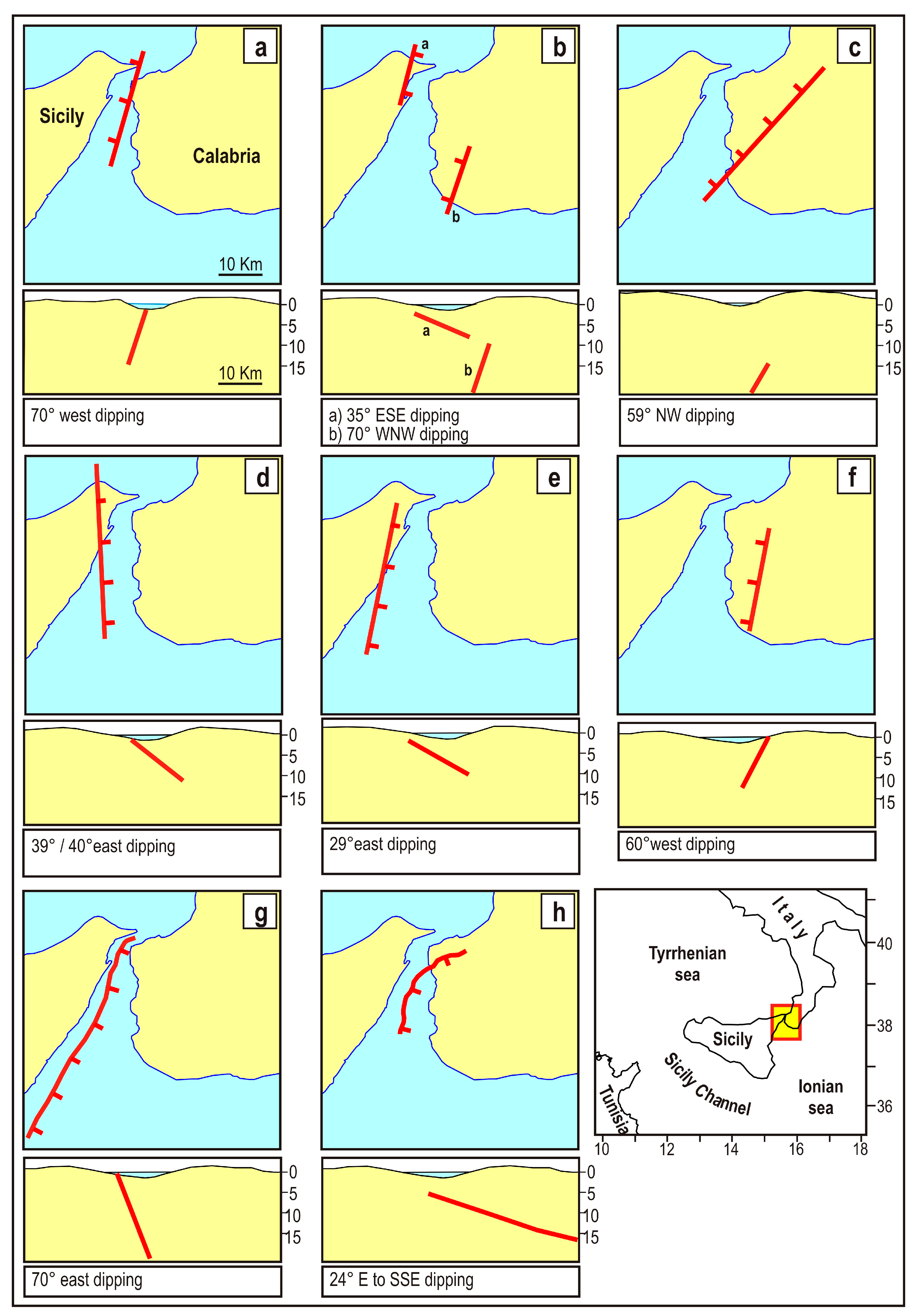

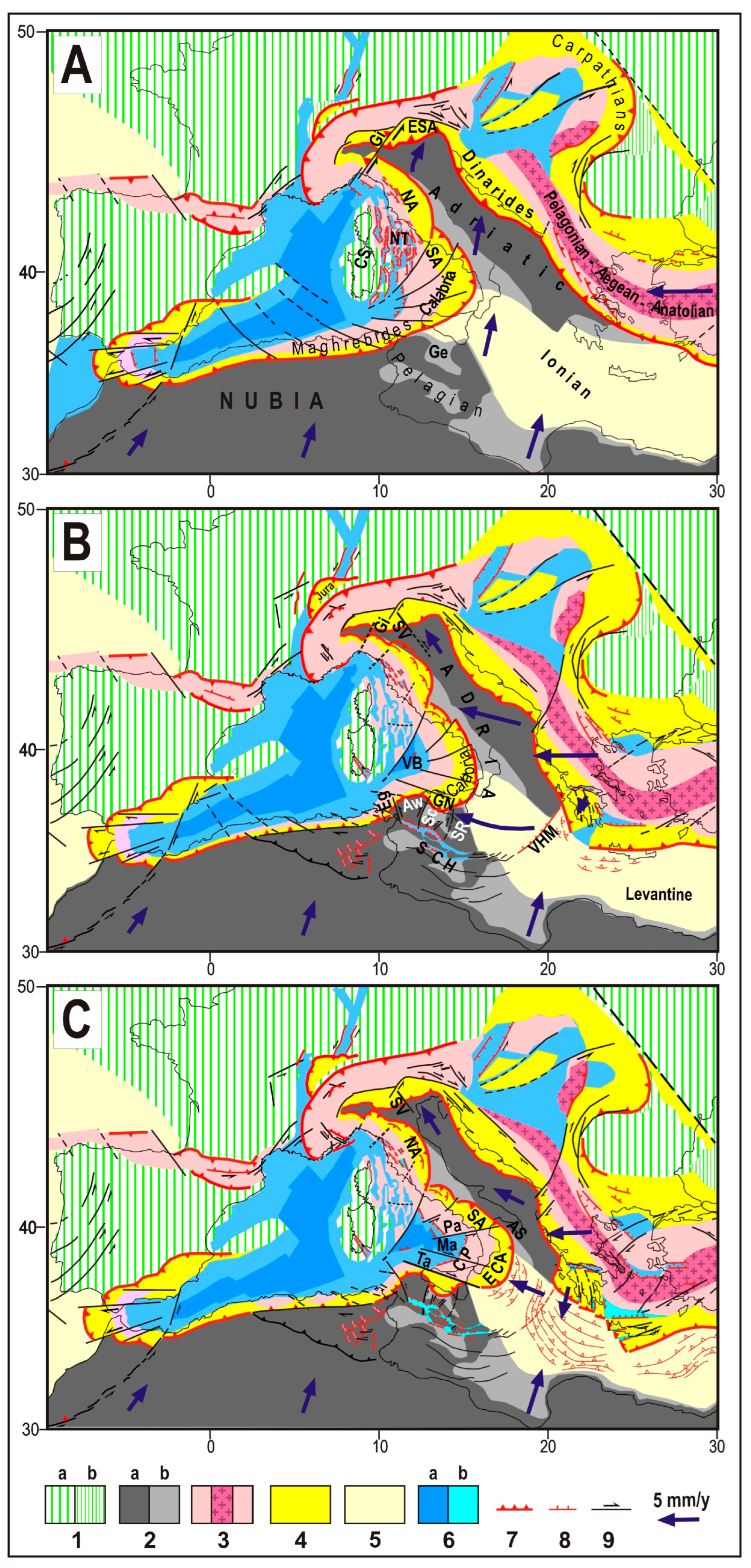
Disclaimer/Publisher’s Note: The statements, opinions and data contained in all publications are solely those of the individual author(s) and contributor(s) and not of MDPI and/or the editor(s). MDPI and/or the editor(s) disclaim responsibility for any injury to people or property resulting from any ideas, methods, instructions or products referred to in the content. |
© 2023 by the authors. Licensee MDPI, Basel, Switzerland. This article is an open access article distributed under the terms and conditions of the Creative Commons Attribution (CC BY) license (https://creativecommons.org/licenses/by/4.0/).
Share and Cite
Mantovani, E.; Viti, M.; Babbucci, D.; Tamburelli, C. Generation of the Quaternary Normal Faults in the Messina Strait (Italy). Geosciences 2023, 13, 248. https://doi.org/10.3390/geosciences13080248
Mantovani E, Viti M, Babbucci D, Tamburelli C. Generation of the Quaternary Normal Faults in the Messina Strait (Italy). Geosciences. 2023; 13(8):248. https://doi.org/10.3390/geosciences13080248
Chicago/Turabian StyleMantovani, Enzo, Marcello Viti, Daniele Babbucci, and Caterina Tamburelli. 2023. "Generation of the Quaternary Normal Faults in the Messina Strait (Italy)" Geosciences 13, no. 8: 248. https://doi.org/10.3390/geosciences13080248
APA StyleMantovani, E., Viti, M., Babbucci, D., & Tamburelli, C. (2023). Generation of the Quaternary Normal Faults in the Messina Strait (Italy). Geosciences, 13(8), 248. https://doi.org/10.3390/geosciences13080248






